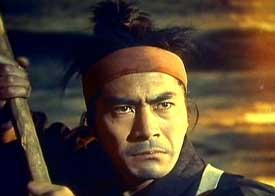 Cinamtographer Jun Yasumoto was replaced by Kazuo Yamada for the plodding final third of Samurai Trilogy, Duel on Ganryu Island (Miyamoto Musashi kanketsuhen: Ketto Ganryujima, Toho, 1955). The major stylistic change that came with the new photographer seems to be a greater number of facial close-ups that give it a made-for-television look long before the arrival of telefilms.
Cinamtographer Jun Yasumoto was replaced by Kazuo Yamada for the plodding final third of Samurai Trilogy, Duel on Ganryu Island (Miyamoto Musashi kanketsuhen: Ketto Ganryujima, Toho, 1955). The major stylistic change that came with the new photographer seems to be a greater number of facial close-ups that give it a made-for-television look long before the arrival of telefilms.
For a film so well planned out in advance (indeed, as a remake of the same director's black & trilogy Musashi Miyamoto, 1940, Inagaki had a great deal of practice ahead of time to get this thing right), the look of Samurai Trilogy is bewilderingly different with each part, perhaps only because they were not filmed back to back with identical crew.
The first film of three was shot on many outdoor locations so is in many ways the best looking part. The second was shot predominantly on interior stages with heightened color effects, so is a little more artificial than Part I. And the final third was likewise shot on interiors but with too many talking heads.
Much of this episode's tedium stems from the two women obsessed with the wandering swordsman Musashi, Akemi & Otsu (Mariko Okada & Kaoru Yachigusa), dominating long loquatious scenes.
Their characters are profoundly male-derived & never come off with strength or realism. Rather, these characters are built up from kitschy cliches to arrive at the ultra-good suffering & prayerful Otsu who seems crippled by her own femininity, at any moment bound to collapse; & angry-manipulative Akemi screwing with people due to her unebbing bitterness & pain. The actresses struggle inside these unreal stereotypes but nothing can make their dialogue appealing.
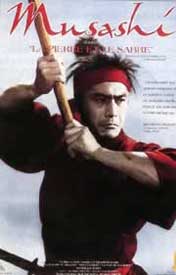 It perhaps bares some notice that director Hiroshi Inagaki did not quite actually adapt the series directly from the novel by Eiji Yoshikawa, but from the intermediary text of a theater play by Hideji Hojo.
It perhaps bares some notice that director Hiroshi Inagaki did not quite actually adapt the series directly from the novel by Eiji Yoshikawa, but from the intermediary text of a theater play by Hideji Hojo.
Hojo streamlined his stage narratives but his primary influences were from & for the kabuki theater. He loved writing excessive female roles for men to play, including even Tamasaburo Bando of the great Kabuki-za.
He similarly loved writing very silly male roles for young girls to play in the campy all-girl Takarazuka Theater which virtually forces girls to live in virginal seclusion then perversely has them play out love stories together.
Some mistook Hojo for a "feminist" because he liked to write such extravagant female character roles, but they were always most extravagant for onnagata or female impersonators & play into the burlesque inherent to the artform.
Because female impersonation is ritualistically important to kabuki, perfectly awful scenes are written for female characters to be perform, often in the manner of squeeling aging faggy men who require exaggeration & artifice & enough make-up for each show to to keep a whorehouse stocked for a year. Within these roles, the toss of a sleeve or a pigeon-toed shuffle of a foot is supposed to be zowwy wowza because, by gum, it's guys moving in stylized female manners, ain't it just so interesting.
And yes, it's a very interesting phenomenon, these single-sex theater traditions with their actual roots in harlotry & pedarasty, & of undeniable cultural significance. But when adapting such material to the camera, a completely different standard much closer to realism is required. Due to the problem of Hiroshi Inagaki's comprehension of women being so confined by stereotypes, he could not repair the artificiality of Hideji Hojo's kabukisms. Thus Akemi & Otsu in particular are forced to make what were essentially drag queen roles come off as actual women.
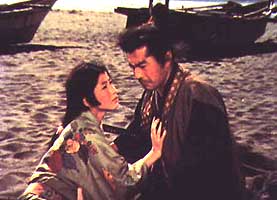 Taking those unreal burlesques of men playing women to the screen with women playing women, it is no longer simply amazing to see an arm move in a sleeve the way a woman might move if she were exaggerating herself. But it explains why Otsu's femaleness is defined as weakness to the point where she can barely walk; or Akemi's femaleness is defined by seductive bitchiness.
Taking those unreal burlesques of men playing women to the screen with women playing women, it is no longer simply amazing to see an arm move in a sleeve the way a woman might move if she were exaggerating herself. But it explains why Otsu's femaleness is defined as weakness to the point where she can barely walk; or Akemi's femaleness is defined by seductive bitchiness.
In losing the burlesque absurdity of kabuki artistry, there was just no reason to stretch out the scenes with such lame dialogue. Especially where Hiroshi Inagaki is concerned, he's constitutionally incapable of directing women as well as he directs men, so it was simply a bad idea to focus so long on mere whiners & manipulators.
The florid emotionalism of Akemi & Otsu is in sharp contrast to the scowling miserableness of Mifune's performance which swings from wild rage to pokerfaced as a sedated zombie. He always seems either peevish or depressed, when he's supposed to be achieving a degree of Zen perfection of swordsmanship. At times Musashi badgered by Akemi & Otsu is like watching a couple angry ferrets mauling a stump.
Otsu continues to whine & fall down helplessly. Akemi gets nastier & nastier. And many a viewer will get wearier & wearier of these gals, just as Musashi seems to be getting used to them. The introduction of a third dull female stereotype doesn't help. Omitsu (Michiko Saga), Kojiro's betrothed, is a less wretched parody of a woman than eitehr Otsu or Akemi, but she doesn't do much of interest either.
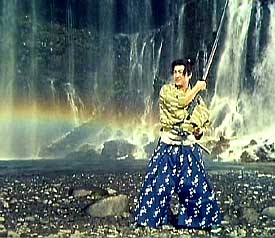 Yet the film comes alive whenever Koji Tsuruta is on stage as Kojiro!
Yet the film comes alive whenever Koji Tsuruta is on stage as Kojiro!
He uses his "swallow-turn cut" to actually cut a swallow from the sky. This is something his girlfriend warns him is "bad luck" in the 1966 film Kojiro, but in the present film Kojiro merely boasts, "Not everone can do that!"
He has a chance to be hired as a sword instructor to an important clan, but is annoyed to find out Musashi is being considered too. He becomes more & more impatient to duel Musashi.
But for complex reasons, Musashi avoids the first chance to duel. Then the middle-portion of the film strays from the central theme of Musashi & Kojiro's inevitable duel.
Tomu Uchida's six-film epic treatment of the same story shows Musashu usually in the company of small boys. Inagaki streamlines the story so that Musashi only picks up one boy along the way, the orphanted Jotaro (Kenjin Iida, who seems never to have acted in anything but parts II & III of this trilogy), making no effort to get rid of him the way he always does with adult women.
It is a curious statement that while women are a nuisance to have around while one is travelling, little boys are never in the way at all & are just the thing to have about.
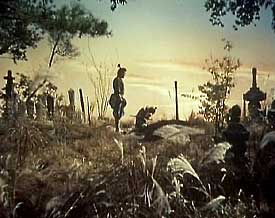 The trilogy is, overall, as Joan Mellon perceptively states in The Waves at Genji's Door (Pantheon, 1976), "latently homosexual." Even the cat & mouse pursuit of butch Musashi with girlishly beautiful Kojiro results in the almost sexual dance of phallic swords. The trilogy is, overall, as Joan Mellon perceptively states in The Waves at Genji's Door (Pantheon, 1976), "latently homosexual." Even the cat & mouse pursuit of butch Musashi with girlishly beautiful Kojiro results in the almost sexual dance of phallic swords.
None of which is at all out of place historically, given the predilection among actual samurai for "comrade love" & the "teacher/pupil romances" even in the medieval literature by such authors as Ihara Saikaku (1642-1693).
During his travels with the little boy, Musashi fights the grotesque Priest Agon of Hozoin Temple in Nara, a monastery famed for its yari-jutsu or spear-fighting. In Inagaki's film it is an open-air affair, virtually a circus.
Musashi had no intention of fighting the priest, but the nasty fellow insists. Musashi holds him at bay with ease, until the abbot comes to inform Agon, "You cannot win."
In Tomu Uchida's version, Musashi came to the temple specifically to fight Agon. It takes place in a dojo or training hall, & Musashi kills the priest without qualm.
As is too often the case with Inagaki, he wished to "clean up" Musashi's act, but really only makes him less interesting. It is easier to believe in Rentaro Mikuni's uncouth Musashi in Yasuo Kohata's Miyamoto Musashi (1954) who all but spits & drools; & certainly Kinnosuke Yorozuya's middle-ground portrayal provides a Musashi with the most complex a personality.
Mifune as Musashi settles down to farm land near a village terrorized by bandits, who will soon enough reckon with the new farmer.
Inagaki may have assumed the viewer was familiar with the book (as in Japan, just about everyone would've been), for the film does not state why Musashi considered farming necessary to his training. In Tomu Uchida's version, it is explicitly because Musashi has observed Zen-like similarities between farming & swordsmanship.
After various complications of plot (but not of character), Musashi is drawn back into the vicinity of Kojiro Sasaki of Isarago, saving us from yet enother half hour of the whining women who followed Musashi to his farmstead.
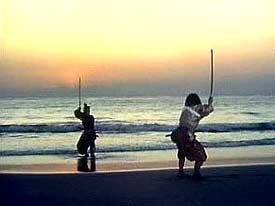 The famous encounter on Ganryu Island is excellently done in all versions ever filmed by anyone, & it saves Part II of Inagaki's trilogy from pedestrianism.
The famous encounter on Ganryu Island is excellently done in all versions ever filmed by anyone, & it saves Part II of Inagaki's trilogy from pedestrianism.
Musashi wins the the encounter by a trick rather than superior skill, by arriving late with the blinding sun behind his shoulder. Musashi considers tactical planning an integral part of swordsmanship, so he is being more than cheatingly clever.
Usually Inagaki undermines Musashi's trickster personality because Inagaki wants to believe in a Musashi who never cheats, but some of his nature bleeds through to the screen this time; & in fact Musashi for this encounter does not seem at all the fellow who pursued swordsmanship in a Zen manner, but he has reverted to the youth who fought with a hand-carved wooden sword more club than bokken. He's again the wild man that Inagaki had striven until now to obliterate in favor of a nobler Musashi who historically did not exist.
Also left unsaid in Inagaki's film is that this duel occurred illegally, for duels were banned in the Tokugawa era, thus necessitating the trip to a barren islet in the Kammon Straits.
In the novel it's very obvious that the duel was covertly sponsored by men of official standing, who secretly planned to slay Musashi if he won, to cover up their involvement & avoid the disgrace of having it known that their champion was defeated. Yet by Inagaki's account, one of Kojiro's sponsors (Takashi Shimura) congratulates the winner & everything about the duel is treated as though it had been above-board.
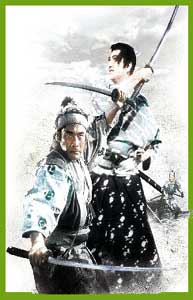 But in Tomu Uchida's account, Musashi timed the tides to a perfect degree, knowing he would have to escape Kojiro's treacherous sponsors. But in Tomu Uchida's account, Musashi timed the tides to a perfect degree, knowing he would have to escape Kojiro's treacherous sponsors.
This was another instance of Musashi's tactical superiority. Inagaki streamlined both plot & character so that the theme of tactical excellence -- or trickster lack of honor -- never entirely plays through.
It is, however, a wonderfully staged duel along the beach, scruffy Musashi armed with rustic carved board, dandified Kojiro armed with his extra-long sword.
As the film closes the beautiful Kojiro lays dead on the beach of Ganryu Island with a smile upon his face. Whatever the subterfuges of the men around him, for Kojiro, this was what he risked with a true heart, without regret for any outcome. He has met his destiny happily.
Musashi is being rowed back to the main island, tears streaming down his face, having admitted that he would never meet another swordsman as fine as Kojiro in his entire life. Given the grim-visaged Musashi played by Toshiro Mifune, having him at last break down into tears makes a powerful end.
An epilog of sorts can be found in Inagaki's stunning black & white Young Swordsman (Hiken, 1963), probably his best film. In this one the young swordsman has non-violent encounters with an elderly Musashi who lives more for Zen & woodcarving than for swordsmanship, & counsels young samurai to learn the abacus.
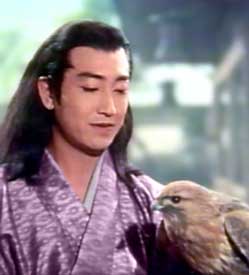 In summation for the entirity of Samurai Trilogy, it is undeniably enjoyable & has moments of stunning beauty & fewer moments of excellence. But it is by no means superior to other versions of Eiji Yoshikawa's popular historical novel, nor is it anywhere near the quality of such thoroughgoing classics as Kurosawa's Seven Samurai (Shichinin no samurai, 1954) or any number of maximumly artful Japanese movies of the '50s.
In summation for the entirity of Samurai Trilogy, it is undeniably enjoyable & has moments of stunning beauty & fewer moments of excellence. But it is by no means superior to other versions of Eiji Yoshikawa's popular historical novel, nor is it anywhere near the quality of such thoroughgoing classics as Kurosawa's Seven Samurai (Shichinin no samurai, 1954) or any number of maximumly artful Japanese movies of the '50s.
The United States & Europe were still in the thrall of discovering Japanese films when a re-edited first part of Samurai Trilogy was tossed to the west like a bone to a hungry dog. Which films were seen outside Japan was as much a matter of company politics as quality, & the 1954 Special Oscar could probably have gone to any one of half a dozen better films if their director's had the pull with their studios that Inagaki had with his.
The influence of Eiji Yoshikawa's novel as well as Musashi's more authentic biographical details have had far-reaching influences in the samurai film genre. In additon to scores of films, tv shows, comic books, novels, biograhies, video games, & action figures for Musashi & his nemesis Kojiro, a vastly larger number of films bear the mark of Musashi Miyamoto's life & legend even without being about Musashi.
The character of Genji Kuro, played by Kinnosuke Nakamura in three films, fought with Musashi's nito-ryu two-sword style. The long-running series about Kyoshiro Nemuri "the full-moon swordsman" starred Raizo Ichikawa as a traveling ronin devoted to his sword & mistrusting women. Musashi's belief in satori or enlightenment as achievable thrugh the sword is echoed in the series about Shingo Aoi, the shogun's illegitimate son (who however dresses more like Kojiro), played by Hashizo Okawa.
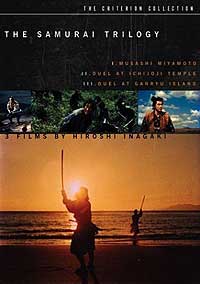 The slovenly element of Musashi's life & character was played best by Rentaro Mikuni in Kohata's Musashi film, but the broader character type was made famous by Toshiro Mifune in such films as Yojimbo (1961) & Sanjuro (Tsubaki Sanjuro, 1962). The slovenly element of Musashi's life & character was played best by Rentaro Mikuni in Kohata's Musashi film, but the broader character type was made famous by Toshiro Mifune in such films as Yojimbo (1961) & Sanjuro (Tsubaki Sanjuro, 1962).
In fact is, Kurosawa had the histrocial Musashi in mind when he cast Mifune as the dirty elemental firebrand Kikuchiyo in Seven Samurai. In many, many, many films, small elements of Musashi's complex life & personality are excised to create fictional characters.
Director Hiroshi Inagaki was less an impact on the samurai film genre than Musashi, but it must be acknowledged that Inagaki used the character the most often, over the greatest number of years. And one thing he did superbly was introduce Musashi to the American & European audience.
It woudl be a couple decades before the novel itself appeared in English, or Musashi's own writings in The Book of Five Rings became a cult classic for Wallstreet businessmen. And yet long before the books were widely distributed in English, Musashi Miyamoto was already well-known in the west.
Inagaki's Samurai Trilogy made Musashi more than just a Japanese culture-hero. It made him one of the great folk figures of world history, known to millions of people in scores of nations, most of whom will forever automatically assume Musashi looked exactly like Toshiro Mifune.
copyright © by Paghat the Ratgirl
|
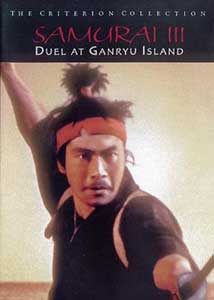




 The trilogy is, overall, as Joan Mellon perceptively states in The Waves at Genji's Door (Pantheon, 1976), "latently homosexual." Even the cat & mouse pursuit of butch Musashi with girlishly beautiful Kojiro results in the almost sexual dance of phallic swords.
The trilogy is, overall, as Joan Mellon perceptively states in The Waves at Genji's Door (Pantheon, 1976), "latently homosexual." Even the cat & mouse pursuit of butch Musashi with girlishly beautiful Kojiro results in the almost sexual dance of phallic swords.
 But in Tomu Uchida's account, Musashi timed the tides to a perfect degree, knowing he would have to escape Kojiro's treacherous sponsors.
But in Tomu Uchida's account, Musashi timed the tides to a perfect degree, knowing he would have to escape Kojiro's treacherous sponsors.
 The slovenly element of Musashi's life & character was played best by Rentaro Mikuni in Kohata's Musashi film, but the broader character type was made famous by Toshiro Mifune in such films as
The slovenly element of Musashi's life & character was played best by Rentaro Mikuni in Kohata's Musashi film, but the broader character type was made famous by Toshiro Mifune in such films as